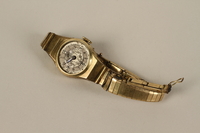Overview
- Description
- The collection consists of pre-war, wartime, and post-war photographs of Esther Vardi and her family in Tacovo (Tiachiv, Ukraine) and a postcard written by Esther to her sister Zippora in Rehovot. Esther participated in underground activities in Budapest during the war. She was caught and deported to Auschwitz.
- Credit Line
- United States Holocaust Memorial Museum Collection, Gift of Esther Vardi
- Collection Creator
- Esther Vardi
- Biography
-
Esther Schaechter (later Vardi) was born June 11, 1922, to Pinchas and Julia Schaechter, the fifth of eight children in an Orthodox Hassidic family. They lived in Tacovo (Tyachev), near the border of Czechoslovakia and Romania. Esther helped support her family with her sewing skills, often being paid with flour and food. In March 1944, when Hungary was invaded by the Germans, Esther joined her older sister, Zipporah (b. 1920), in Budapest and enlisted in the underground Zionist movement. She obtained false papers under the name Barbara. She never worried that she would be caught because she looked Aryan, not Jewish. But in May 1944, while on a mission to the Kisvarda ghetto with 10 sets of false documents, she was arrested by the Gestapo and imprisoned. She managed to destroy the documents but after 10 days in prison, during which she was beaten and interrogated, she admitted she was Jewish. The Zionist movement sent Rafi Ben Shalom to try and get her released but he was unsuccessful; Esther was sent to a larger prison in Budapest. There she met other members of the youth movement.
In June 1944, Esther and other members of the Zionist youth movement were transported by train to the Auschwitz concentration camp; a few group members managed to jump from the train en route. Upon arrival in Auschwitz, Esther was given the number A-10 674 and selected for work, first in C lager, then in a factory in B lager. Her job was to sew underpants made from the clothes brought by the inmates for the workers being sent to Germany. Esther was in Auschwitz until January 1945, immediately prior to the liberation of the camp by the Russian Army. The camp was evacuated and the inmates were sent on a death march.They ate snow to survive. Esther had wooden clogs and is sure that without them, she would not have survived. Her group eventually reached a train station and was shipped to Bergen-Belsen. Esther contracted typhus but was there when the camp was liberated by the British Army on April 26, 1945. During her time in Auschwitz and Bergen-Belsen, Esther was part of a group of 3-4 friends who helped each other survive. After liberation, she recovered from typhus and became strong enough to work in the camp kitchen.
Now 23 years old, Esther left in August for Prague to search for her family. She found her sister, Zippi, in Budapest, but learned that their younger brother, David (b.1924), had perished. Indeed, except for their older brother, Yossi (b. 1916), who had emigrated to Palestine in 1938, their entire family had perished. In April 1944, their parents and 5 siblings had been sent to Auschwitz, directly to the gas chambers. Esther immigrated to Palestine in 1946 where she married and had 3 sons and several grandchildren. She would eventually live on Kibbutz HaOgen, of which her brother Yossi was a founding member.
Physical Details
- Genre/Form
- Photographs.
- Extent
-
1 folder
- System of Arrangement
- The collection is arranged as a single series.
Rights & Restrictions
- Conditions on Access
- There are no known restrictions on access to this material.
- Conditions on Use
- The Museum is in the process of determining the possible use restrictions that may apply to material(s) in this collection.
Keywords & Subjects
- Geographic Name
- Tiachiv (Ukraine)
Administrative Notes
- Holder of Originals
-
United States Holocaust Memorial Museum
- Legal Status
- Permanent Collection
- Provenance
- The collection was donated to the United States Holocaust Memorial Museum by Esther Vardi in 2009.
- Record last modified:
- 2024-03-04 16:29:57
- This page:
- https://collections.ushmm.org/search/catalog/irn37483
Download & Licensing
- Copyright Not Evaluated
- Terms of Use
- This record is not digitized and cannot be downloaded online.
In-Person Research
- Request 7 Days in Advance of Visit
- Plan a Research Visit
-
Request in Shapell Center Reading Room
Bowie, MD
Contact Us
Also in Esther Vardi collection
The collection consists of a watch, documents, and photographs relating to the experiences of Esther Vardi and her family in Hungary before, during, and after World War II, and of Esther's arrest and imprisonment in several concentration camps for her resistance activities during the Holocaust.
Date: 1938-1946

Woman's engraved gold wrist watch given to one inmate by another in Auschwitz
Object
Gold and silver engraved wrist watch given to 22 year old Esther (Edit) Schaechter in Auschwitz concentration camp around January 1945. The person who gave Esther the watch told her that she knew that Esther was going to survive and she wanted it preserved. Esther kept the watch through the death march to and imprisonment in Bergen-Belsen. Esther had been arrested by the Germans with false papers in Budapest in 1944 where she was active with the Zionist youth movement resistance activities. She was sent to Auschwitz in June 1944, given the number A-10 674, and selected for work duty as a seamstress. In January 1945, Soviet forces arrived in the area and the camp inmates were sent on a death march to Bergen-Belsen. They were liberated by the British Army on April 26, 1945. Esther searched for her family after the war and found her sister, Zipporah, in Budapest. She learned that the rest of her family had been killed, most of them in March 1944, when they were sent to the gas chambers in Auschwitz. In 1946, Esther immigrated to Palestine where her remaining brother, Yossi, had fled in 1938.



